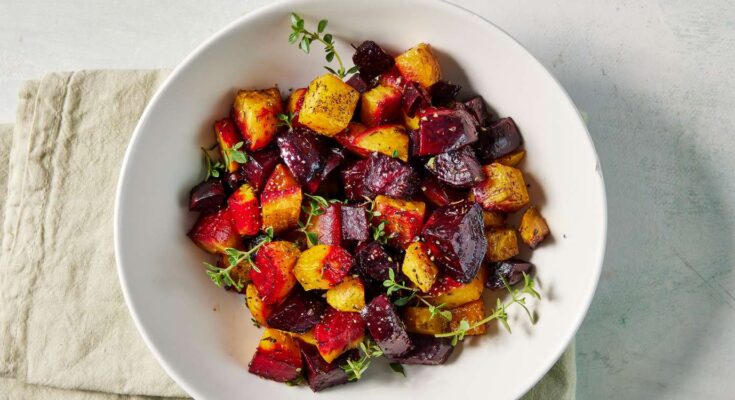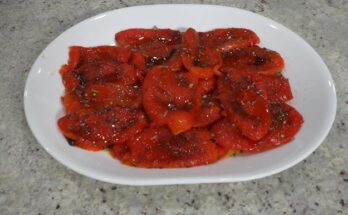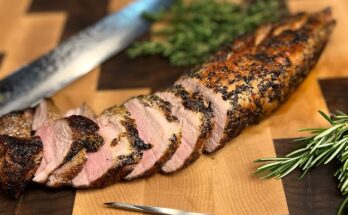Roasted Beet Recipe: Beets are one of those root vegetables that people either love or hate—until they try them roasted. Roasting beets is like uncovering their sweet, earthy charm and bringing out their natural depth of flavor. If you’ve only had boiled or pickled beets and weren’t impressed, it’s time to give them another shot—this time roasted.
Roasted beets are incredibly versatile. You can add them to salads, use them in wraps, mash them into dips, or simply enjoy them warm with a touch of olive oil and sea salt. Their deep ruby color isn’t just beautiful—it’s a signal of their nutrient density. And the roasting process? Easy, hands-off, and totally worth it.
Why roast instead of boil? Because boiling can water down the taste and leach out nutrients. Roasting, on the other hand, caramelizes the natural sugars in the beets, leaving you with a richer, sweeter flavor and a firmer texture that holds up beautifully in almost any dish.
Whether you’re new to beets or already a fan, this guide will walk you through everything you need to know to roast beets to perfection—from picking the right ones to serving them in delicious ways.
Ingredients You’ll Need
Roasting beets doesn’t require a long grocery list or fancy ingredients. In fact, the beauty of this recipe lies in its simplicity. However, using high-quality ingredients makes a huge difference in taste and nutrition.
Fresh Ingredients for Maximum Flavor
Here’s what you’ll need to roast basic beets:
- Fresh beets – Choose firm, unblemished beets with the greens still attached if possible. Red beets are classic, but golden or Chioggia (striped) beets are great too.
- Olive oil – A good drizzle helps with caramelization and adds a rich flavor.
- Salt – Sea salt or kosher salt works best for seasoning.
- Pepper – Freshly ground black pepper adds a mild kick.
Optional Add-Ons for Extra Taste
While basic roasted beets are amazing on their own, you can elevate them with:
- Garlic cloves – Roasted alongside for a warm, mellow flavor.
- Fresh herbs – Think thyme, rosemary, or dill.
- Balsamic vinegar – A splash after roasting adds a sweet tang.
- Goat cheese or feta – Perfect for topping your beets if serving in a salad.
Kitchen Tools You’ll Need
No fancy kitchen gadgets are required, just a few essentials:
- Baking sheet or roasting pan
- Aluminum foil or parchment paper
- Sharp knife and cutting board
- Vegetable brush or scrubber
- Gloves (optional, to avoid stained hands)
If you’ve got all that lined up, you’re ready to start roasting. Let’s dive into the actual process.
Step-by-Step Guide to Roasting Beets
Now, for the fun part. Roasting beets isn’t just easy—it’s kind of therapeutic. Follow these steps and you’ll end up with deeply flavored, tender, and naturally sweet roasted beets every single time.
Step 1: Choose and Prep the Beets
Start with fresh, firm beets. They should feel heavy for their size and not have any soft spots. If the greens are still attached, that’s a good sign—they should be vibrant and not wilted. Cut the greens off about an inch above the beetroot. Don’t throw them away; beet greens are edible and packed with nutrients.
Give the beets a good scrub under running water using a vegetable brush. You don’t need to peel them yet—roasting will make the skins super easy to remove later. Once cleaned, pat them dry with a towel.
Depending on the size of the beets, you can leave them whole or halve them. Smaller beets roast faster and can be left whole. If they’re large, consider cutting them in half or quarters to speed up cooking.
Step 2: Seasoning the Beets
While some people roast beets without any seasoning and flavor them after roasting, a little pre-seasoning goes a long way. Place your cleaned and trimmed beets on a sheet of aluminum foil or in a roasting pan. Drizzle them with olive oil, and sprinkle with salt and pepper.
If you’re using garlic or herbs, tuck them in around the beets or wrap everything together in foil to lock in flavor. For a deeper herb-infused taste, toss the beets with thyme or rosemary before roasting.
If you’re not into foil, use a covered Dutch oven or a baking dish with a lid. This keeps the beets moist while allowing them to caramelize.
Step 3: Roasting Process
Preheat your oven to 400°F (200°C). Place the beets in the oven, either wrapped in foil or in a covered roasting dish.
Roasting time depends on the size of your beets:
- Small beets (golf ball size): 30–35 minutes
- Medium beets (tennis ball size): 40–50 minutes
- Large beets: 60+ minutes
To check for doneness, pierce a beet with a fork or skewer. If it slides in easily, your beets are done. Don’t rush this step. Undercooked beets are hard and bland, while properly roasted ones are tender and sweet.
Let them roast, check occasionally, and be patient—it’s worth the wait.
Step 4: Cooling and Peeling
Once your beets are roasted and tender, take them out and let them cool for 10–15 minutes. Don’t try to peel them while they’re hot—it’s a guaranteed way to burn your fingers.
After they’ve cooled slightly, use your hands or a paper towel to rub the skins off. They should slip right off. If they’re stubborn, a paring knife can help. Gloves can be useful here, especially if you’re working with red beets—unless you’re aiming for that pink-fingered chef look!
After peeling, trim off the tops and roots if you haven’t already.
Step 5: Serving Suggestions
Roasted beets are fantastic warm or cold, solo or as part of a bigger dish. Here are some ideas:
- Slice and toss into a fresh green salad with goat cheese, arugula, and walnuts.
- Chop and serve as a simple side dish with a drizzle of balsamic glaze.
- Puree them into a beet hummus or dip.
- Serve warm with a pat of butter and pinch of flaky salt.
They also pair beautifully with citrus, grains like quinoa, and fresh herbs. The natural sweetness and earthy tones make them incredibly versatile.
Flavor Variations to Try
If you’re looking to switch up the flavor profile of your roasted beets, you’ve got a world of options to explore. Beets are incredibly versatile and can handle bold spices, sweet enhancements, or tangy dressings. Here are some flavor variations that will make your roasted beets stand out and suit different types of meals and moods.
Sweet & Savory Roasted Beets
Want a combination of flavors that feels like a warm hug? Try pairing roasted beets with both sweet and savory elements.
- What to use: Olive oil, honey or maple syrup, sea salt, and a touch of cinnamon or cumin.
- How to do it: After cleaning and prepping your beets, drizzle them with olive oil and honey or maple syrup. Sprinkle a pinch of sea salt and your spice of choice (cinnamon for warm notes or cumin for a deeper savory kick).
- Why it works: The sweetness highlights the beets’ natural sugars, while the spices provide depth.
This version pairs incredibly well with grilled meats, autumn salads, or as part of a holiday spread.
Spicy Garlic Roasted Beets
If you like a little heat in your food, this one’s for you. Beets can hold their own against bold flavors like chili and garlic.
- What to use: Olive oil, minced garlic, red pepper flakes or cayenne pepper, and sea salt.
- How to do it: Toss your prepped beets with olive oil, garlic, and a sprinkle of spice. Roast as usual and finish with a squeeze of lemon for brightness.
- Why it works: The garlic caramelizes during roasting, and the chili adds a punch that contrasts beautifully with the beets’ sweetness.
This variation is excellent in grain bowls or tacos, or even as a spicy side for roasted chicken or tofu.
Balsamic Glazed Beets
A classic and sophisticated twist, balsamic vinegar and roasted beets are a match made in culinary heaven.
- What to use: Olive oil, balsamic vinegar, salt, and fresh thyme or rosemary.
- How to do it: Roast your beets as usual, then toss them with balsamic vinegar and herbs during the last 10 minutes of cooking.
- Why it works: The acidity of the vinegar cuts through the sweetness of the beets, while the herbs round everything out.
Perfect for elegant salads, charcuterie boards, or a vegetarian main course.
Storage and Reheating Tips
You’ve roasted a batch of delicious beets—now what? If you’ve got leftovers or like to meal prep, knowing how to store and reheat them is key to maintaining their texture and flavor.
Best Practices for Storing Leftovers
Roasted beets store beautifully and can even taste better the next day as the flavors develop. Here’s how to keep them fresh:
- Refrigerate in an airtight container: Once cooled and peeled, place your beets in a glass or BPA-free plastic container. They’ll stay good for up to 5 days.
- Keep whole or sliced: Whole beets retain more moisture, but sliced ones are ready to grab and go. Choose based on how you plan to use them.
- Don’t pre-dress: If you plan to toss them with dressing or glaze, do it just before serving to prevent sogginess.
If you’re planning to store longer, consider freezing.
- Freezing Tip: Roasted beets can be frozen for up to 3 months. Freeze them in single layers on a baking sheet first, then transfer to a freezer-safe bag or container. Thaw in the fridge before reheating.
How to Reheat Without Losing Flavor
Reheating roasted beets the wrong way can make them soggy or bland. Here’s how to keep them just as tasty:
- Oven or toaster oven: The best method. Reheat at 350°F (175°C) for about 10–15 minutes. It brings back some of that roasted crispness.
- Stovetop: Heat in a nonstick pan over medium heat for 5–7 minutes. Add a touch of oil or butter to refresh the flavor.
- Microwave: Fast but not ideal if you want crispy edges. Use low power and cover with a microwave-safe lid to retain moisture.
Want to reinvent leftovers? Toss them into a warm quinoa bowl, blend into a beet soup, or stir into a frittata.
Nutritional Benefits of Beets
Roasted beets aren’t just tasty—they’re incredibly good for you. Every bite delivers a powerful punch of nutrients, antioxidants, and health-boosting compounds. Here’s a breakdown of why you should make roasted beets a regular part of your diet.
Rich in Antioxidants
Beets are loaded with betalains, a type of antioxidant that gives them their rich red or yellow color. These compounds have been shown to reduce inflammation and help the body fight oxidative stress.
- Betalains may help protect against chronic diseases such as heart disease and certain cancers.
- They also support liver function, helping the body detoxify more efficiently.
- Roasting helps preserve these compounds better than boiling.
Beets also contain vitamin C, another powerful antioxidant that supports immune function and skin health.
Great for Heart Health and Digestion
Beets contain high levels of nitrates, which convert into nitric oxide in the body. This compound helps relax blood vessels, improving blood flow and reducing blood pressure.
- Studies show that drinking beet juice or eating roasted beets can significantly lower blood pressure in just a few hours.
- The fiber content in beets (especially if eaten with the skin) supports healthy digestion and can help with weight management.
- Beets also provide folate, essential for heart health and prenatal development.
So if you’re looking to boost energy, lower blood pressure, or just feel better overall, beets are a smart choice.
Common Mistakes to Avoid
Even though roasting beets is simple, there are a few mistakes that can ruin your batch. Here’s what to watch out for so you don’t waste perfectly good produce.
Overcooking or Undercooking
Timing is everything with roasted beets. Overcooking can make them mushy and dry, while undercooking leaves them too firm and earthy.
- Always test for doneness by piercing with a fork or skewer.
- Remember that different sizes and beet types cook at different speeds.
- If you’re roasting mixed sizes, cut larger beets to match smaller ones.
Not Using Enough Seasoning
Beets have a bold flavor, but that doesn’t mean they don’t need seasoning.
- Salt enhances the natural sweetness.
- Olive oil is not just for flavor—it helps with caramelization.
- Adding herbs or spices during roasting brings complexity and depth.
Under-seasoned beets can taste flat and won’t win over beet skeptics.
Peeling Before Roasting
Unless you absolutely need peeled raw beets for another recipe, don’t peel them before roasting.
- The skins help trap moisture and flavor.
- Roasted skins slip off easily, saving you time and mess.
- Peeling raw beets not only stains your hands but also wastes some of the nutrients close to the skin.
Avoiding this mistake will make your roasted beets more flavorful and easier to prep.
FAQs about Roasted Beet Recipe
1. Can I roast beets with other vegetables?
Yes! Beets pair well with carrots, sweet potatoes, parsnips, and onions. Just make sure to cut all veggies to similar sizes for even roasting.
2. Do I need to peel beets before eating?
Nope! The skins slip off easily after roasting. You can even eat the skins if they’re thin and tender, especially on smaller beets.
3. Are roasted beets good for weight loss?
Yes, they’re low in calories, high in fiber, and packed with nutrients. Their natural sweetness also helps curb sugar cravings.
4. What herbs pair best with beets?
Thyme, rosemary, dill, and parsley all complement beets wonderfully. Balsamic vinegar and citrus also enhance their flavor.
5. Can I use an air fryer instead of an oven?
Definitely! Cut the beets into smaller chunks and air fry at 375°F for about 15–20 minutes, shaking halfway through.
Conclusion
All you need are fresh beets, some oil, seasoning, and a bit of patience. With the right techniques, you’ll end up with a versatile and healthy ingredient that can be used in countless meals—whether it’s tossed into a salad, pureed into a dip, or simply enjoyed on its own.
We’ve covered everything from selecting the right beets and roasting them to perfection, to flavor variations, storage tips, and even the health benefits. Now it’s your turn to head into the kitchen and give it a try. Trust me—once you’ve tasted the sweet magic of roasted beets, there’s no going back.



